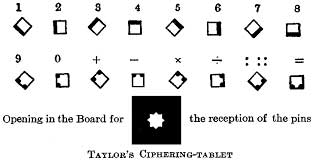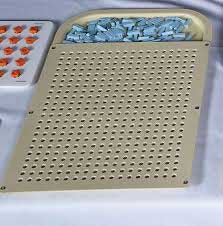Kalyani C
“Mathematics is not about numbers, equations, computations or algorithms; it is about understanding.” – William Paul Thurston (1946 – 2012), American mathematician.
Vision is fundamental to learning. Sighted people obtain information through their vision, especially through their observational skills. Such incidental learning does not happen for non-sighted people. Mathematics is abstract. One of the ways of understanding abstraction is to indirectly mirror them with physical objects and visualize the images. Non-sighted persons are denied of this learning opportunity, which makes learning mathematics a great challenge. Not only math, acquiring basic literacy itself is a great challenge for them. Print material is of no use. They need all print material in the Braille code. Braille is a tactile reading and writing system for the blind. To achieve a literacy level on par with their sighted peers, visually impaired students need to have adequate supply of Braille textbooks. Geometry and spatial sense can be taught through concrete hands-on experiences.
The blind child needs training in using his hands as his ‘eyes’ and this training should start from early childhood at home. The child learns to identify his mother by touch. Their major channels of information are auditory, tactile and kinesthetic. Most of the challenges in learning math can be overcome by teaching them in an appropriate manner. Mathematics can be taught using a combination of tools like the Braille code, Abacus, tactile materials and the Taylor Frame along with the Nemeth Code. Similarly, mathematical concepts can be taught using various geometric shapes of different sizes and textures, felt boards and symbol stickers. Over and above all these, a teacher well-trained in teaching math using all these special devices is a must.
Assistive technology has removed many barriers to education, especially in the understanding of math for visually impaired individuals. A short description of some of these technologies with illustrations is provided for reference in the annex to this article.
Special schools and integrated schools
Children with visual impairment go either to integrated schools or to special schools for the blind. Special schools are schools that are specifically designed, staffed and resourced to provide appropriate education to special children. They are often better equipped to provide individualized education, addressing the specific needs of these children.

Integrated education is not simply about placing a blind child in a regular classroom. The child needs assistance. The most important factor in the education of visually impaired students is the resource teacher. Resource teachers are trained to teach Braille literacy and mathematics using the Taylor Frame along with the Nemeth Code and tactile graphics. In the integrated system of education, a resource teacher is appointed along with regular classroom teachers to take care of the education of the blind children. It is their responsibility to train the students in the plus curriculum as well. Plus curriculum includes, among other things, Braille literacy, learning math using abacus, and Taylor Frame, orientation and mobility training and daily-living skills. Unless these skills are learned and mastered, visually impaired individuals are at high risk of leading a lonely, isolated, unproductive life. The general classroom teacher and the resource teacher have to work together to successfully teach the visually impaired child.
Importance of elementary education
Elementary education in special schools is very important for blind children. It gives a strong foundation for their future learning in the sighted world along with sighted peers. It helps build their self-esteem, self-confidence and prepares them to face their challenges boldly. Whereas, elementary education in integrated schools shatters their aspirations; makes them diffident. Due to shortage of study materials, lack of awareness about their abilities and a lack of empathy from fellow students they are not able to acquire even the basic literacy and numeracy skills. Helping blind students understand their strengths and weaknesses is important while teaching them math.
Situation in our education departments
For the education system to work effectively, particularly for children with special needs, several deep changes are required. The most important is an attitudinal change among administrators in our education departments. MHRD – Ministry of Human Resource Development – should bring education of all children, both non-disabled and disabled under its wing. At present, special education is under the Ministry of Social Justice and Empowerment (MOSJE) while mainstream education comes under MHRD. This creates dichotomy and fragmentation.
The status of most integrated schools in Tamil Nadu which enroll blind children is not satisfactory. There is always a shortage of Braille textbooks as well as resource teachers. Even if the books are available, teachers do not know how to read in Braille nor do they know how to teach mathematics using the Taylor Frame and abacus. To rectify this problem, the government needs to recruit enough resource teachers and give them in-service training.
Visually impaired students in Tamil Nadu learn mathematics only up to class X. They cannot pursue it in their higher studies, not because of a lack of ability, but because there are no teachers to teach them mathematics at that level.

A blind research scholar undertook a study to evaluate the status of education of the blind in the schools of Tamil Nadu.
The research study reveals the following ground realities –
- Resource teachers are not government employees. They are appointed by trusts or non-governmental agencies. They do not receive their salaries on regular basis from these agencies. Due to this problem they are forced to leave the job. Hence, there is always a shortage of resource teachers.
- Seven out of the 17 integrated schools in Tamil Nadu did not have resource teachers.
- Braille textbooks were always in short supply and none of the blind students had their own copies of Braille textbooks to read and practice. They were not provided with tactile maps or tactile graphics for better understanding of concepts. In some cases, though they had Taylor Frames, there was no teacher to teach them mathematics using Taylor Frames or abacus. As the teachers were not trained in Braille, student assessment was done only on their oral skills. Students were not given any written assignment as homework or encouraged to write their answers (in Braille) during examinations.
- In special schools for the blind, students are taught compensatory skills right from class I, whereas in integrated schools it depends on the availability of resource teachers. Hence, most parents preferred sending their blind children to special schools rather than to integrated schools.
Some inspiring stories
In spite of these hurdles, there are students who successfully overcome difficulties and accomplish just about anything their sighted peers can. Some of them have even proved that they can be leaders and that they can help other disabled people in leading a normal dignified life. To name a few –
Beno Zephine, Indian Diplomat, is the first 100% blind Indian Foreign Service Officer.
Arunadevi, government employee, has done her BA, MSW and M Phil in sociology. Along with her friends, who are also disabled, she has formed an organization named, Society for the Rights of All Women with Disabilities and works for the empowerment of disabled destitute women in Tamil Nadu.
Saraswathi, PhD (English Literature) is a teacher in a regular government school in Tamil Nadu teaching English to sighted students up to class 10. She is happily married and has a child.
The way ahead
I conclude by summarizing the most important areas of education, including mathematics education, for the blind which needs to be improved.
1. Training for all teachers to understand the emotional and learning needs of blind children.
2. Adequate resource teachers trained in Braille reading and in using assistive technologies.
3. Strengthening effective elementary education for blind students in all schools.
4. Availability of Braille textbooks for students.

Annex
Assistive technologies
Assistive devices essential for learning compensatory skills are as follows:
- Braille – Braille is a code, a system of six dots that represent the letters of the alphabet. Braille offers distinctive advantages for children who want to learn the fundamentals of language, such as spelling and phonetics.
- Braille Slate – Braille Slate is used in learning Braille dots using the touch and feel method.
- Stylus – Stylus is used in marking the Braille dots on paper.
- Taylor Frame – Taylor’s mathematical frame is used to solve mathematical problems and calculations. It is suitable for teaching arithmetic to visually impaired persons. The Frame has star shaped holes with eight angles, thus allowing double-ended metal types or pegs to be placed in different positions according to a set system. Types or pegs are used to write numbers on the Frame. All basic arithmetic operations can be carried out on the Frame.
- Nemeth Code – Nemeth Code is a special type of Braille used for mathematics and science notations. It was developed in 1946 by Dr Abraham Nemeth (1918 – 2013), a Professor of mathematics. With the Nemeth Code, one can render all mathematical and technical documents into the six-dot Braille. The Nemeth Code has been instrumental in opening up careers in science and mathematics to people who are blind or have other visual impairments.
- Cranmar Abacus – Abacus for the blind students is called Cranmar Abacus. It is a tool used for mathematical calculations. This can also help in one’s daily life, for instance calculating prices while buying groceries or shopping. This is a modified form of the Japanese Abacus, Soroban.
- Geometry Kit – The Geometry Kit, specially designed for visually impaired children enables them to understand geometrical concepts clearly.
- Tactile graphics – Tactile graphics, including tactile maps and tactile graphs are images that use raised surfaces so that visually impaired persons can feel them with their sensitive fingers.
- Screen Reading Software, especially JAWS (Job Access With Speech) and NVDA (Non-Visual Desktop Access), enables them to read all the information available on the internet and acquire knowledge.

The author has been a volunteer for blind students for more than 25 years now. All her students are well placed and leading dignified and independent lives. These days she converts print material into audio for blind teachers in Tamil Nadu. She can be reached at kalyanimouli@gmail.com.
